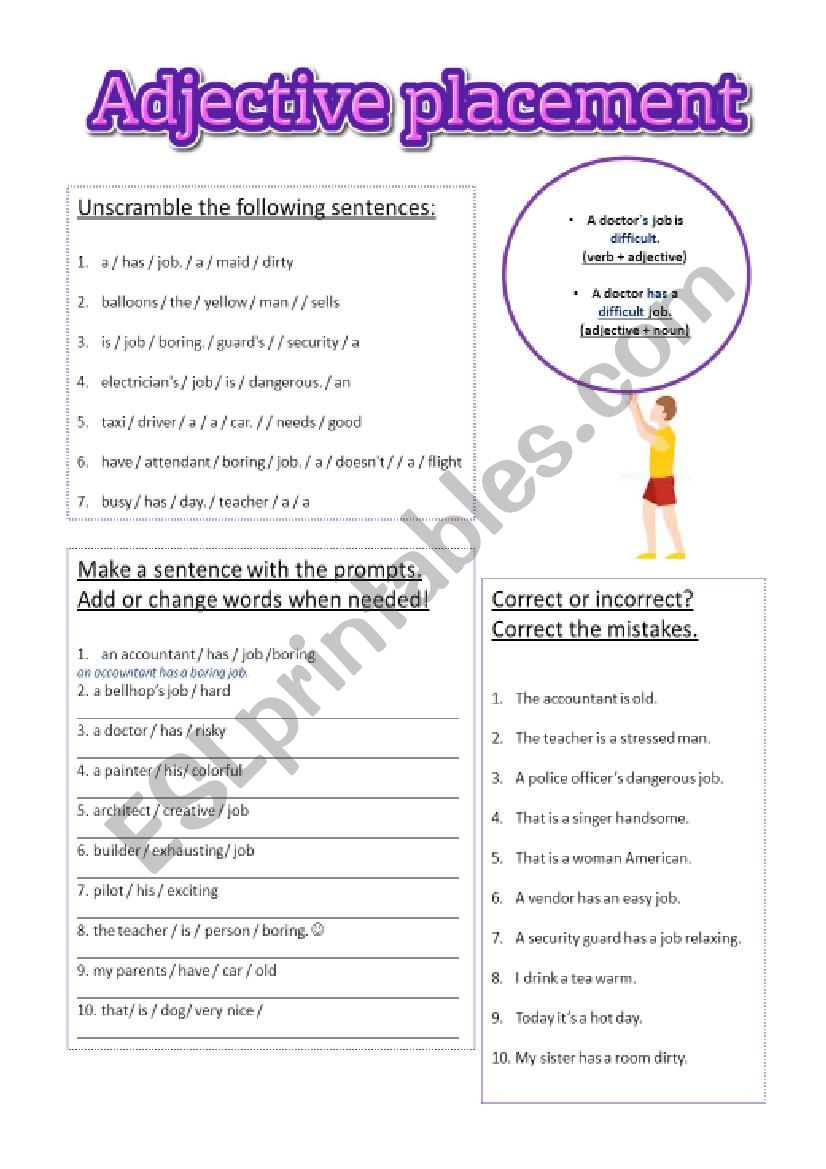
Mastering the Art of Description: The Indispensable Adjective Placement Worksheet
English, a language celebrated for its flexibility and vast vocabulary, can sometimes present a formidable challenge to learners, particularly when it comes to the intricate rules of word order. While nouns, verbs, and even prepositions often find their intuitive spots, adjectives – those vibrant words that add color, detail, and specificity to our language – can be notoriously tricky to place correctly. Misplacing an adjective can lead to awkward sentences, confusion, or even unintended meanings. This is precisely where the power and utility of an adjective placement worksheet come into play.
An adjective placement worksheet is more than just a series of exercises; it’s a structured, pedagogical tool designed to systematically teach, reinforce, and test a learner’s understanding of where adjectives belong in English sentences. From basic attributive positions to the complex order of multiple adjectives, these worksheets provide the targeted practice necessary to transform hesitant speakers and writers into confident communicators.
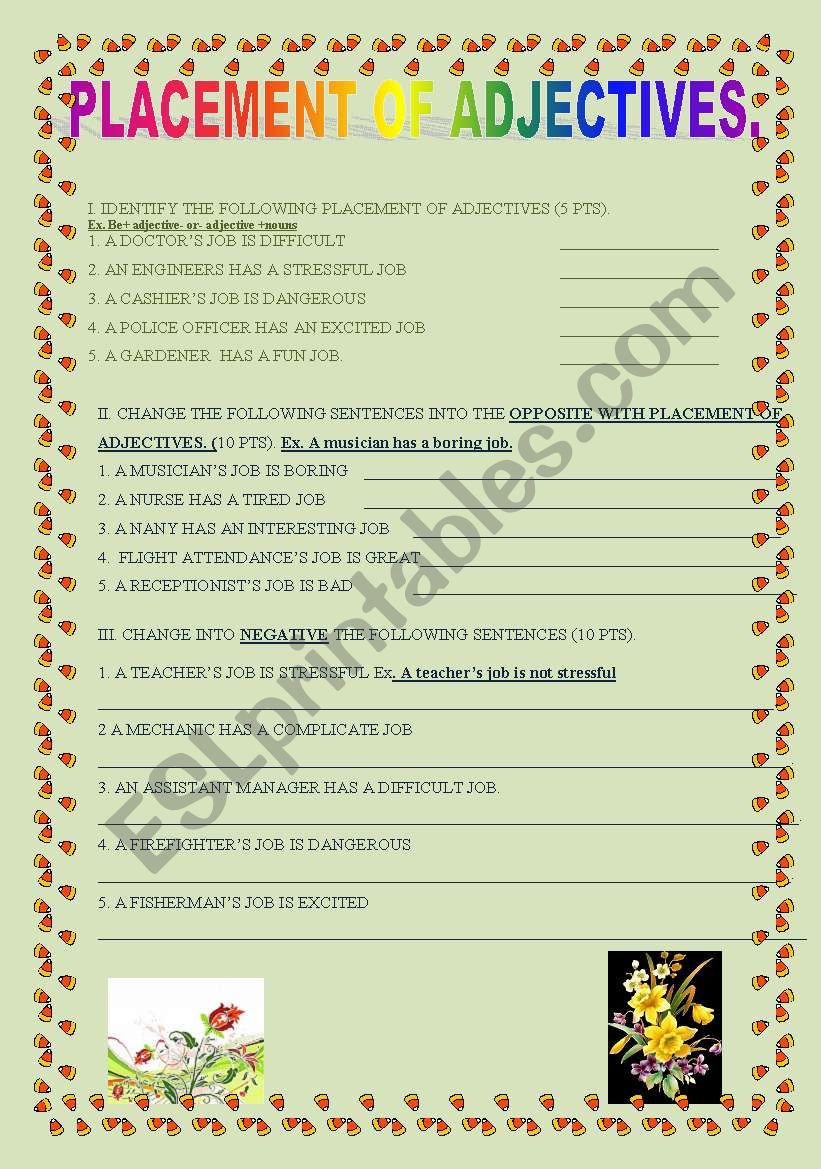
Understanding the Role of Adjectives: More Than Just "Describing Words"

Before delving into placement, it’s crucial to grasp what adjectives are and why they matter. Adjectives are words that modify, describe, or qualify nouns or pronouns. They answer questions like "What kind?" "Which one?" "How many?" or "How much?" Without them, our language would be bland and imprecise. Imagine trying to describe a "car" versus a "shiny, red, vintage sports car." The adjectives bring the image to life.
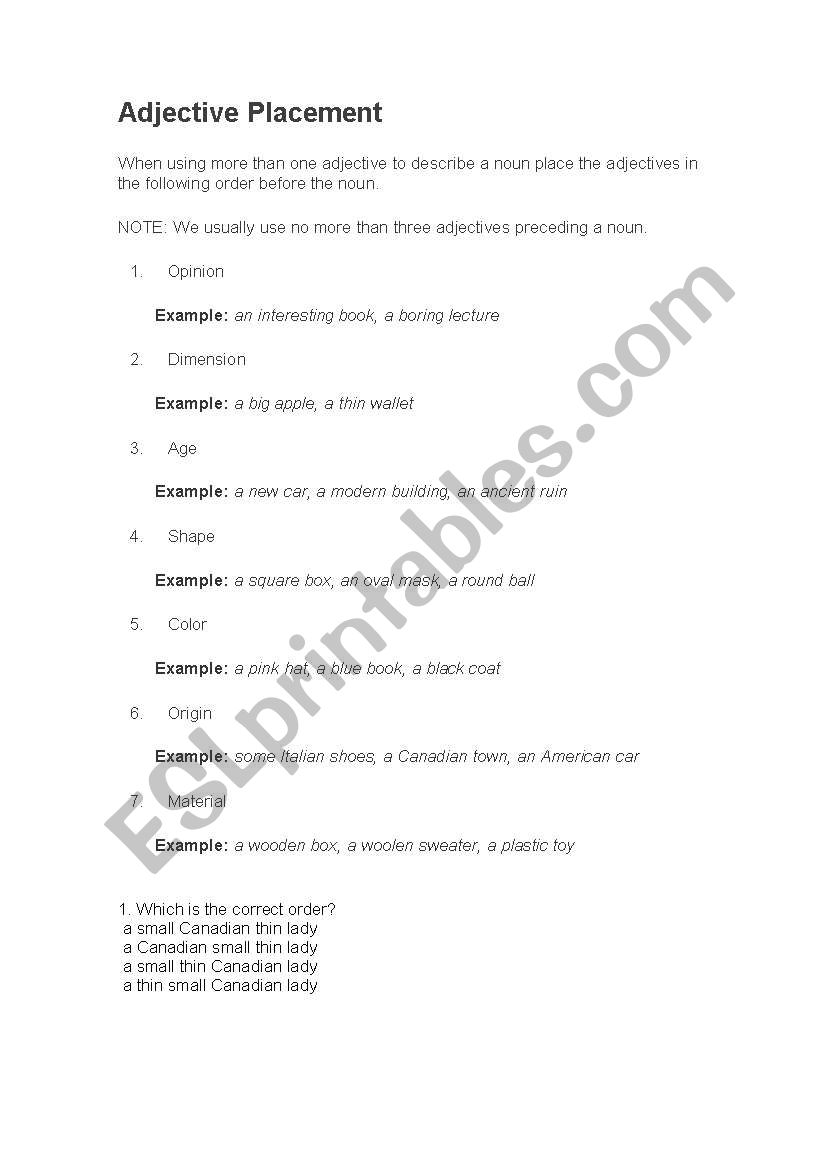
However, unlike some languages where adjectives might always follow the noun or have more flexible positioning, English has specific, often rigid, rules for adjective placement. These rules, while initially daunting, become second nature with consistent practice, much of which can be facilitated by a well-designed adjective placement worksheet.

The Fundamental Rules of Adjective Placement

The vast majority of adjective placement in English falls into two primary categories:
-
Attributive Adjectives (Before the Noun): This is the most common position. An adjective placed before the noun it modifies is called an attributive adjective.
- Examples: a tall building, a delicious meal, happy children, the blue sky.
- Common pitfalls: Learners from languages where adjectives follow the noun (e.g., Spanish, French) often struggle with this, producing phrases like "a building tall" or "a meal delicious."

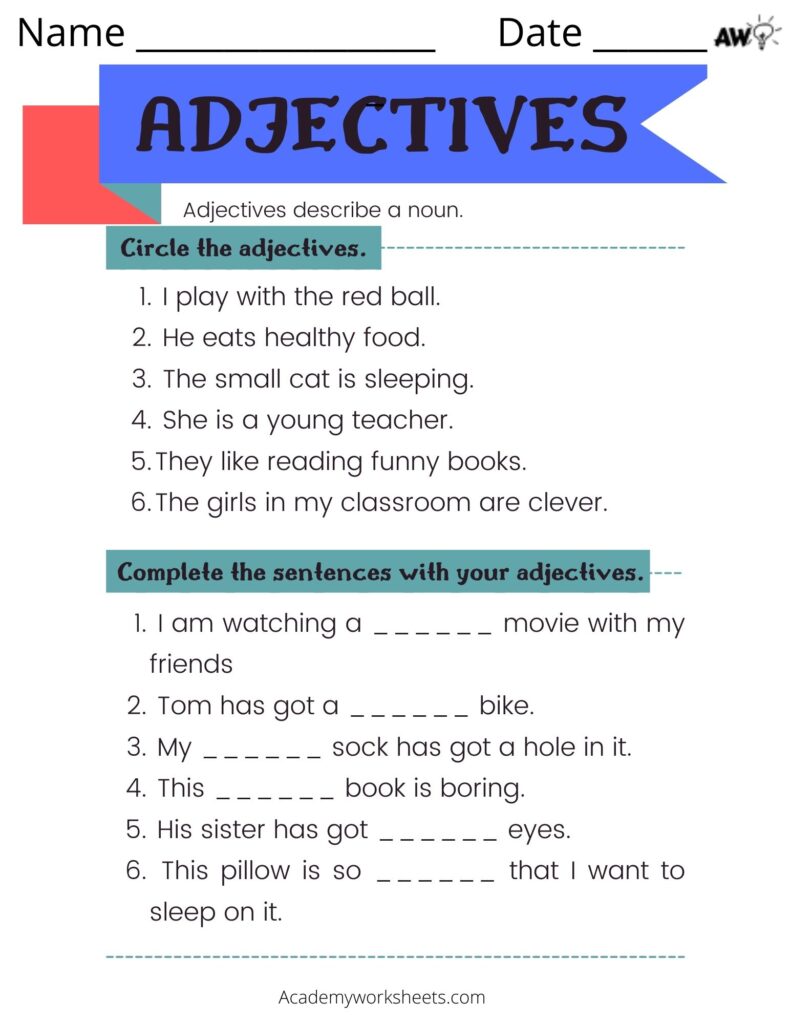
-
Predicative Adjectives (After Linking Verbs): These adjectives follow a linking verb (like be, seem, appear, feel, look, smell, sound, taste, grow, become) and describe the subject of the sentence. They do not directly precede the noun.
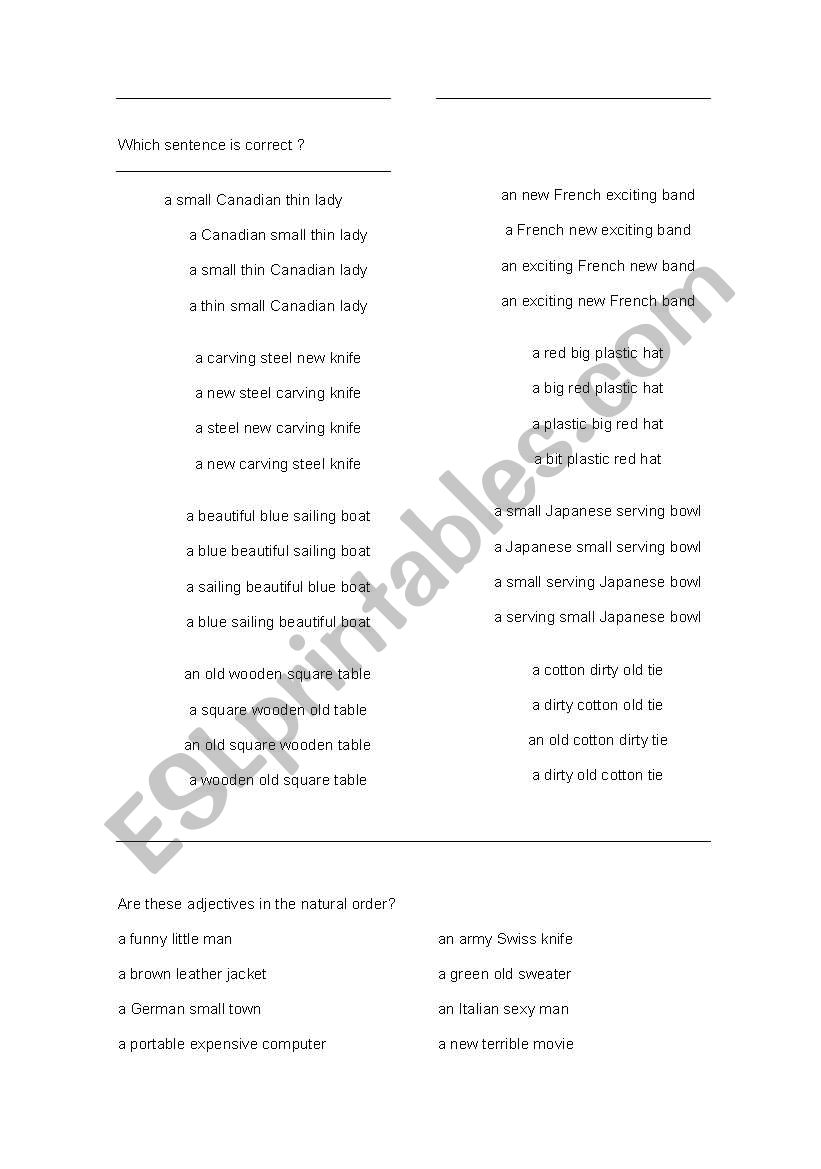
- Examples: The soup tastes delicious. She seems happy. The building is tall. The sky looks blue.
- Key difference: Attributive adjectives are part of the noun phrase, while predicative adjectives are part of the predicate and describe the subject through the linking verb.
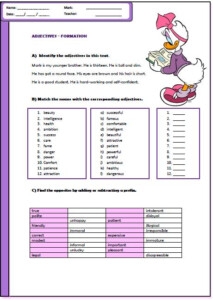
Beyond the Basics: More Nuanced Placement Rules
While the attributive and predicative positions cover most cases, English has several other, more nuanced rules for adjective placement that often trip up learners:
-
Order of Multiple Attributive Adjectives: When more than one adjective modifies a single noun, they follow a generally accepted, though not always consciously known, order. This order is often summarized by mnemonics like OSASCOMP (Opinion, Size, Age, Shape, Color, Origin, Material, Purpose).
- Example: a beautiful (opinion), large (size), old (age), round (shape), red (color), Italian (origin), leather (material), handbag (noun).
- Trying to say "a leather Italian old red handbag" sounds unnatural. This is a prime area where an adjective placement worksheet can provide structured drills.
-
Adjectives with "Enough" and "Too": When using enough or too with adjectives, the adjective always comes before enough but after too.
- Examples: He is tall enough to reach the shelf. (NOT "enough tall")
- It is too hot to go outside. (NOT "hot too")
-
Adjectives with Indefinite Pronouns: When adjectives modify indefinite pronouns (like something, anything, nothing, somebody, anyone, nowhere), the adjective always comes after the pronoun.
- Examples: I need something new. Is there anything interesting to do? We found nobody famous.
-
Adjectives in Fixed Expressions/Idioms: Some adjectives are part of fixed phrases where their placement might seem irregular but is simply idiomatic.
- Examples: "attorney general," "body politic," "heir apparent." These are less about rule application and more about memorization.
-
Post-Positive Adjectives (Adjectives After the Noun): Though rare outside of fixed expressions, some adjectives can appear after the noun, especially in formal or literary contexts, or when the adjective is part of a longer phrase.
- Examples: "The only person available was John." (Here, "available" describes "person" but is placed after because it implies "who was available.")
- "something special," "everyone present."
Why Correct Adjective Placement Matters
The importance of correct adjective placement extends beyond mere grammatical correctness; it impacts clarity, naturalness, and even the perceived professionalism of communication.
- Clarity and Precision: Correct placement ensures that the adjective clearly modifies the intended noun, preventing ambiguity. "A big, red, old truck" is clear. "An old, big, red truck" is also clear but sounds slightly less natural. "A truck big old red" is confusing.
- Natural Sounding English: Native speakers intuitively follow these rules. Deviations often make sentences sound awkward or "foreign," even if the meaning is decipherable. This can hinder effective communication in real-world scenarios.
- Professionalism and Credibility: In academic writing, business correspondence, or formal presentations, adherence to grammatical norms, including adjective placement, contributes to the speaker’s or writer’s credibility. Errors can distract the audience and undermine the message.
The Indispensable Role of the Adjective Placement Worksheet
Given the complexities, how does one effectively learn and internalize these rules? The answer lies in systematic practice, and that’s precisely what an adjective placement worksheet offers.
- Targeted Practice: Unlike general grammar exercises, an adjective placement worksheet hones in specifically on this one challenging aspect. This focused approach allows learners to concentrate on the rules without being overwhelmed by other grammatical considerations.
- Reinforcement and Repetition: Mastery comes through repetition. Worksheets provide ample opportunities to apply the rules over and over again, solidifying understanding and building muscle memory for correct placement.
- Identification of Weaknesses: As learners complete the exercises, they (or their instructors) can easily identify specific areas where they struggle. Do they consistently misplace adjectives with indefinite pronouns? Do they forget the order of multiple adjectives? This diagnostic capability allows for targeted intervention.
- Variety of Exercise Types: An effective adjective placement worksheet typically includes a range of exercise types to engage different learning styles and reinforce understanding from various angles:
- Fill-in-the-blank: Students insert an adjective into a given sentence in the correct position.
- Sentence Reordering: Students are given a jumbled set of words (including adjectives and nouns) and must reorder them to form a grammatically correct sentence.
- Error Correction: Students identify and correct misplaced adjectives in provided sentences.
- Sentence Transformation: Students rewrite sentences, adding adjectives in the correct positions.
- Multiple Choice: Students select the sentence with the correct adjective placement from several options.
- Creative Writing Prompts: Students are asked to write sentences or short paragraphs using a given set of adjectives, encouraging active application of the rules.
Designing and Utilizing an Effective Adjective Placement Worksheet
For educators creating these resources, or for learners seeking them out, certain features define an effective adjective placement worksheet:
- Clear Instructions: Ambiguous instructions can hinder learning.
- Gradual Difficulty: Start with basic attributive and predicative positions, then introduce multiple adjectives, special cases (enough/too, indefinite pronouns), and finally, error correction or more complex reordering.
- Contextual Examples: Sentences that reflect real-world scenarios make the learning more relevant and memorable.
- Answer Key: Essential for self-assessment and immediate feedback, allowing learners to understand their mistakes and correct them.
- Visually Appealing Layout: A clean, uncluttered design helps maintain focus.
For learners, approaching an adjective placement worksheet strategically means:
- Reviewing the Rules First: Before attempting exercises, quickly review the main rules of adjective placement.
- Working Systematically: Don’t rush. Complete each exercise carefully.
- Using the Answer Key Wisely: Check answers only after completing a section. Analyze mistakes to understand why they were wrong.
- Not Giving Up: Adjective placement can be tricky. Persistence is key.
Beyond the Worksheet: Integrating Practice
While the adjective placement worksheet is an invaluable tool, it’s part of a larger ecosystem of language learning. To truly master adjective placement, learners should also:
- Read Extensively: Pay attention to how native speakers use adjectives in books, articles, and online content.
- Listen Actively: Notice adjective placement in movies, TV shows, podcasts, and conversations.
- Speak and Write Regularly: Actively try to incorporate correctly placed adjectives into their own spoken and written English. Seek feedback on their usage.
- Engage in Communicative Activities: Role-playing, debates, or descriptive games can provide a low-stakes environment for practicing adjective use.
In conclusion, mastering adjective placement is a crucial step towards achieving fluency and accuracy in English. It enhances clarity, makes communication sound more natural, and boosts confidence. The adjective placement worksheet stands out as an indispensable tool in this journey, offering the structured, targeted practice necessary to conquer this often-challenging aspect of English grammar. By embracing the systematic approach provided by these worksheets, learners can transform their descriptive abilities and communicate with greater precision and eloquence.
